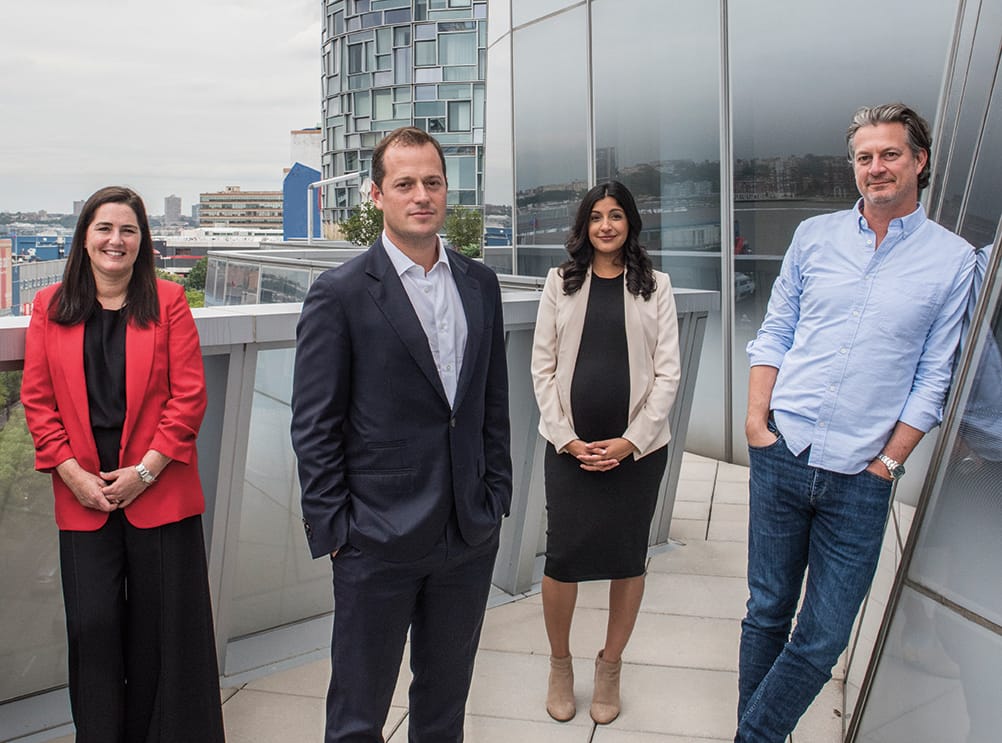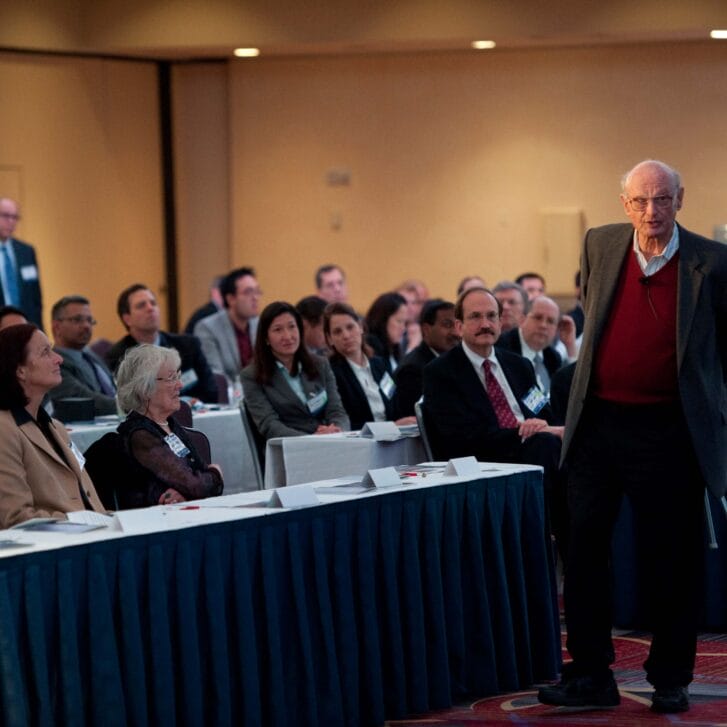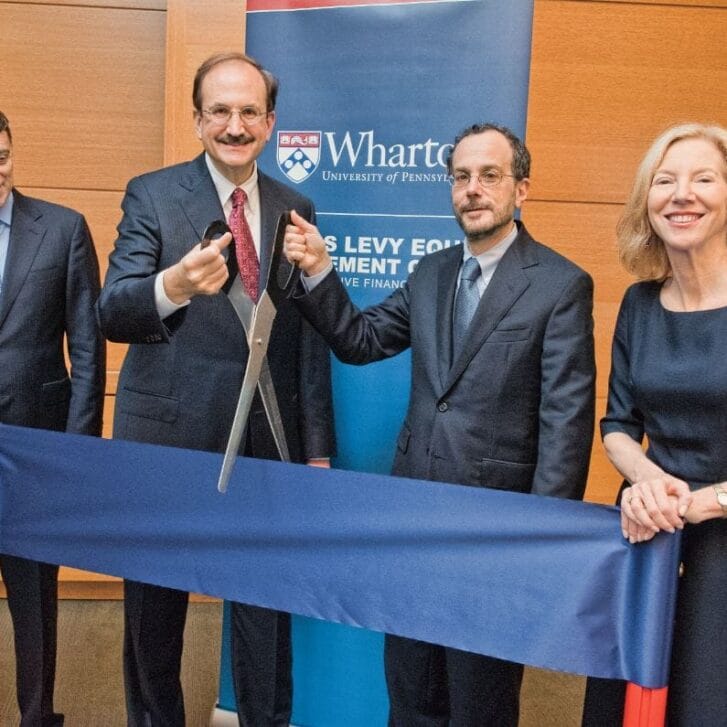It’s hard to overlook the metaphor in the scene outside the corner office of Joey Levin ENG01 W01 at InterActiveCorp headquarters in Chelsea. A gorgeous view of the Hudson River is partially disrupted by a major construction project next door—but for this 39-year-old CEO, it’s simply a sign of progress. Constant change and forward motion are the nature of his business: Founded by entertainment icon Barry Diller, IAC is a collection of more than 150 internet companies that touch nearly every aspect of our digital lives. Need a plumber? Need a date? Ready to remodel your kitchen? Looking for better tools to create a social media presence for your company or personal brand? The portfolio of websites Levin oversees can help with all of that. And what’s more, three of his crown jewels—the dating sites of Match Group, video creation site Vimeo, and the personal-resource sites of Dotdash—are run by fellow Wharton alumni. (See the sidebars to meet Levin’s C-suite dream team).
Levin was a natural choice to lead a panel on “The Future of Technology and Transformation of Daily Living” at the Wharton Global Forum in New York in June. (For full video of the discussion, visit the Wharton Magazine Facebook page.) Prior to joining IAC in 2003, he worked in technology mergers and acquisitions for Credit Suisse First Boston; after joining Diller’s firm, Levin held a variety of roles—from M&A to overseeing search and applications software—that eventually led him to the CEO’s chair in 2015 and regular appearances on “40 Under 40” lists for Forbes and Fortune. Two weeks after the Global Forum, Levin sat down to carry the conversation further and share his thoughts on working for an industry giant, taking the fear out of data acquisition, and the next big things in tech. —Richard Rys

Joey Levin ENG01 W01
CEO of IAC
Wharton Magazine: Let’s start with some insight into your relationship with Barry Diller.
Joey Levin: He’s my boss; there’s that. [laughs] He’s been a mentor, friend, confidant, all those things. I’ve learned a lot from him, and I continue to learn. One of the reasons our relationship works and has lasted as long as it has is because I trust him completely and he trusts me completely. You kind of need that in this setup of an organization.
An interviewer once asked Diller about his talent development strategy, and he described it as throwing people in the deep end and watching them eventually get up to the top for air. Was there a deep-end moment for you at IAC?
I still have deep-end-in-the-pool moments. [laughs]
Frequently?
No, not that frequently. Well, maybe. I think in every role I’ve been in at IAC, and everywhere in my career, almost by definition you have no idea what you’re doing when you start. Sometimes that learning curve is steep, sometimes it’s less steep, but there’s always a curve, and that’s what keeps things interesting. I’ve had periods where I had a lot to learn and it seemed like too much. But you get into it relatively quickly, and you pick it up.
What were the challenges for you in transitioning from the financial side of this business?
Going from the finance side to the operations side is a big transition. The finance side is very black-and-white and precision—numbers don’t lie; they’re crystal clear. The operations side is much more judgment and accountability. If there’s something that looks wrong or looks like it could be better, it’s your problem to fix it. And knowing that everything is your problem, not to identify but to fix, is a big change. That’s one of the most fun challenges—you can and must fix every problem that you discover. That was hard to do. Still is hard to do.
Was there a particular problem you solved that became a formative experience for you?
One of our businesses [then called Mindspark] had a significant dependence on one partnership. And at any moment, that partnership could have issues. We had to make real changes to our business quickly to address that partnership. And at the same time, we had to keep all the employees motivated and energized around a business that was going through a dramatic—and what at the moment looked like it could be devastating—change. Keeping everybody fired up, excited, and ready and prepared to do the work necessary to make those changes was a very defining moment for our company and management team.
How do both sides of your Management and Technology degree serve you in this job?
I actually think that both are similar in many ways in solving problems and thinking about problems. The systems engineering is kind of about breaking problems down into component parts—what are all the pieces that make up the problem, and then you test all of those pieces until you find the weakness that needs to be solved. That applies to all industries, all problems, and all forms of management. But that thinking process of breaking it down is a sort of fundamental engineering concept. And the finance side kind of allows me to understand the big picture—the bigger economic picture, the bigger environmental picture. It’s a way of thinking and a way of pushing your brain.
What about your own strategy for finding talent and cultivating it?
It’s very similar to Barry’s. We look for people with ambition and passion on the topic. And we look for people who are self-starters in whatever it is that excites them and motivates them. We embrace this idea that we’re not a place that does a lot of training or has management programs or sticks to tracks or fixed titles and everything moves on a schedule. Everyone says “meritocracy”—it’s really that people who seek opportunities will get them. We like the idea of giving people a chance and seeing what they learn. People who say to us in an interview or in a note, “I see an opportunity to do what you’re doing but do it much better”—I love hearing that.
Like Vimeo CEO Anjali Sud W05, who rose through the ranks of the company the same way you did.
She’s a great example of that. I was running Vimeo on an interim basis for close to a year. The company divided into two pieces. One was Anjali’s side, tools for video creators, and the other was using the Vimeo platform to be a destination where we were creating our own content for audiences. At some point, she said to me, “I can make this business much bigger under the strategy that I’m learning.” And I said, “Great, do it.” And she did. We scrapped [the content creation] and moved everybody onto the other when we promoted Anjali to CEO.

From left: Anjali Sud W05, Joey Levin ENG01 W01, Mandy Ginsberg WG01, and Neil Vogel W92
Given the scope of businesses that you oversee, how do you find a balance between acquiring the next big thing and not overextending?
We take risks, but we’ll never bet the company on something. We have to invest in the distant future while we’re investing in the present. If we go back 10 years ago, Match was not considered by the public or by investors to have the potential that it’s proven it has today. Nor was ANGI Homeservices [which oversees sites including Angie’s List and HomeAdvisor] perceived that way. We always believed in both of them and saw great potential, and ultimately that came to be. We have to focus on those next things—the Angies and Matches of 10 years ago today.
What’s that next big thing?
The internet has shown us the amazing breadth of options available for anything. I think if we look five or 10 years forward, the range of options is going to be overwhelming, and you’ll want the programs that you trust to deliver the one answer. Things like AI and machine learning are going to be very helpful in delivering that one answer. Younger generations trust the platform to deliver that one solution more than prior generations ever have. Take, for example, ANGI Homeservices. We ask older consumers what they want in home-service professionals, and they say, “I want you to introduce me to a few different providers, and I want to negotiate with them. I want to figure out if I’ve got the right price and the right person.” You ask a younger person, and they say, “Why did you give me three? I just wanted my toilet fixed as quickly and reliably as possible. You’re the one that knows all the plumbers. Get me the right one, and let me trust you do to do that.”
Voice is another trend. Increasingly, consumers are using voice as a medium for getting answers to things. It used to be you typed in text; now you ask a voice assistant. When you ask a question by voice, you want one answer. So the more we go toward voice, the more it accelerates the consumer expectations, because the medium requires it.
If those are the exciting frontiers, what keeps you up at night as you think about the future?
We’re entering a world where the large internet platforms have significant power, and I think that’s something that we, not just as a company but as Americans, need to keep a close eye on. The amount of info that these companies have and the value of the data they have is just now beginning to be understood; it still remains relatively underrated and underappreciated. We need to make sure that that is always used as a force for good in continuing to maintain competitive markets.
There was a presumption that the public had a better understanding of how much data was being collected and how it was being used than it really did. The Cambridge Analytica story proved that.
Here’s the fundamental issue. Consumers can understand and appreciate and accept a valid value exchange. You might value your privacy—you don’t want an app you use to know exactly where you are at all times. However, you’re probably comfortable giving your location to Uber in order to speed up the process by which you can order a car to take you from point A to point B. You understand that value exchange. In the case of Cambridge Analytica, that value exchange was never made clear. That is the world we need to navigate, and that is where Facebook failed in that example. But Facebook has done a great job in acknowledging those mistakes and trying to fix them. The key to good brands is making sure those value exchanges pass the smell test, so a consumer can make them with eyes open.
In light of the AT&T and Time Warner merger, how do companies compete in this era of consolidation?
Some of the hardest companies to compete with—though we have in many cases successfully competed with all of them—are Facebook, Amazon, Apple, Google, all those large technology companies that have blown up on the internet. I think the consolidation outside of those is actually good, because it enables more folks to compete. AT&T now combined with Time Warner, competing with those big technology players—that’s fantastic. If they’re willing to take on those kinds of battles, consumers will benefit.
Any piece of advice or lesson learned from your time as CEO of IAC?
The most important thing is that our employees and our shareholders appreciate and value candor and transparency. I’ve found that the more candid and transparent you can be on any topic, the more respect and trust you can generate with the people you work with, you work for, you work around.
Anjali Sud W05 / CEO, Vimeo

Anjali Sud W05
CEO, Vimeo
When Anjali Sud was promoted from general manager/senior vice president to CEO of Vimeo last July, she found herself navigating a team, a company, and an industry undergoing rapid transformation. Vimeo, which already had defined itself as the world’s largest ad-free video platform, was working toward a new goal: to be the service people turn to when they want to create and publish videos. “YouTube and Netflix are destinations for watching videos. Vimeo isn’t a destination,” says Sud, explaining that the company doesn’t invest in content. Instead, Vimeo provides the tools to help people make great content, so they can reach their audiences wherever they choose. The business model is driven by the number of subscribers—not viewers—who are paying for tech services to help host, edit, share, and even sell their stuff over the web.
“Our future is all about finding impactful and innovative ways to empower video creators,” says Sud, who’s based in New York. Under her direction, Vimeo is investing heavily in new technology so pros and amateurs alike are set up to succeed. Maybe it’s a film student creating her first short, or a business unveiling its latest product or rolling out a new marketing campaign. It could even be a professional actor producing a web series worthy of Emmy nominations.
Fighting for the top spot in a crowded space isn’t foreign to 35-year-old Sud, whose post-Wharton jobs have included marketing and business development at both Amazon and Time Warner. She’s already made aggressive moves like acquiring Livestream last fall—the largest acquisition in Vimeo’s history—and is now offering OTT (“over the top”) capabilities that help you capture, edit, and stream content for live events or on-demand viewing. This young CEO’s leadership isn’t going unnoticed: Fortune named Sud, along with Levin, in its 2018 “40 Under 40,” and the Hollywood Reporter included her on its annual list of up-and-coming execs who are positioned to eventually run Tinseltown. Her business strategy seems to be working, too—Vimeo, which has close to a million paid subscribers from around the world, including NPR and Foo Fighters, is on track to exceed $125 million in revenue this year. —Amy Downey
Neil Vogel W92 / CEO, Dotdash.com

Neil Vogel W92
CEO, Dotdash.com
Remember about.com? Chances are you do—after all, it’s been around since 1996—but when was the last time you visited it? That was the issue Joey Levin grappled with shortly after IAC bought it from the New York Times for $300 million in 2012: What do you do when the internet outgrows what was once one of the 20 biggest websites ever? To combat Google search algorithms—plus countless waves of new websites full of specialized content—Levin tapped Neil Vogel in 2013 to try and make About.com matter again.
When Levin asked Vogel, an internet entrepreneur and investor widely known for his Webby Awards, what he thought about the general-information website, Vogel was frank in his response: “I don’t think of About.com.” Still, he was intrigued by the challenge of reviving an internet pioneer. First, the website was redesigned, and the content was beefed up; the result was a prettier, faster, more relevant version of About.com. That iteration brought in some money and traffic, but more drastic measures were needed.
“What we figured out is, About.com wasn’t a brand that was helpful to us—it was actually an albatross,” Vogel says, explaining that you can’t be an expert at everything. “The good news is that our content happens to align with some of the most valuable categories on the internet.” So last May, Vogel shut down About.com and in its place launched Dotdash.com, a destination for several brand-new websites focused on categories that include health, personal finance, tech, travel, and home.
With the right formula pegged, Dotdash—which, in a wink to its past, is Morse code for the letter “A”—quickly made a name for itself. Each of its stand-alone brands is, at minimum, twice as big as when it was launched. Its most popular vertical, Verywell, offers expert advice that ranges from foods that help fight fatigue to tips on getting pregnant. Vogel, who says traffic and earnings are going up “convincingly,” estimates that Dotdash will earn north of $100 million in revenue this year. “We stuck with it and figured out what to do,” he says. “Now, the future is limitless.” —A.D.
Mandy Ginsberg WG01 / CEO, Match Group

Mandy Ginsberg WG01
CEO, Match Group
Mandy Ginsberg’s favorite matchmaking story came from a dad who wrote to her explaining that all three of his daughters found their husbands via her flagship dating service. Though he was thrilled and grateful they were all in happy and healthy relationships, their love came at a (literal) cost—he now had three weddings to pay for thanks to Match. “Technological advancements have given us incredible access to people with whom we otherwise wouldn’t cross paths. It’s enabled us not only to connect with new people, but to form meaningful relationships outside of our own social circles,” says Ginsberg, adding that more than a third of U.S. marriages now start online.
The Dallas-based Match Group, which has more than 45 brands in its portfolio, from OkCupid to Tinder, was taken over by Ginsberg last year. (She was previously in charge of Match Group Americas, where she focused on the Match U.S. brand in addition to North and South American expansion.) While the company is already profitable—it raked in more than a billion dollars last year—and is active in 190 countries and 42 languages, it’s looking for even more global exposure in markets like India, Brazil, and Russia. Says Ginsberg: “The online dating stigma has definitely been broken down in the U.S., though it remains in other countries.”
Before joining IAC in 2012, Ginsberg was CEO of the Princeton Review, for which she launched online services like tutoring and college counseling. She’s also take-charge when it comes to her personal life: She was just three days into Wharton’s famous MBA Math Camp when she unexpectedly became a single mom—her ex-husband moved back to Israel. “I was juggling taking care of a one-year-old while also trying to survive one of the most demanding business schools in the country,” she recalls. “I ended up learning a lot about my capacity to withstand pressure and to rise to the occasion under difficult circumstances.”
“Difficult circumstances” might be the best way to describe the past year or so for Match Group’s most profitable asset, Tinder, which saw a recent $3 billion valuation. Though controversy from lawsuits with competitor app Bumble and former employees made headlines this summer, Ginsberg remains focused on the next frontier of matchmaking—integrating video and voice into profiles, along with using AI and AR to better predict real-life chemistry. Given her status as the doyenne of matchmaking, Ginsberg has some advice for those in the online-dating pool: “The most important thing is to be authentic,” she says. “Be thoughtful about how you want to represent yourself, and truly reflect who you are, not what you think other people are looking for.” —A.D.
Published as “Titans of Tech” in the Fall/Winter 2018 issue of Wharton Magazine.

























